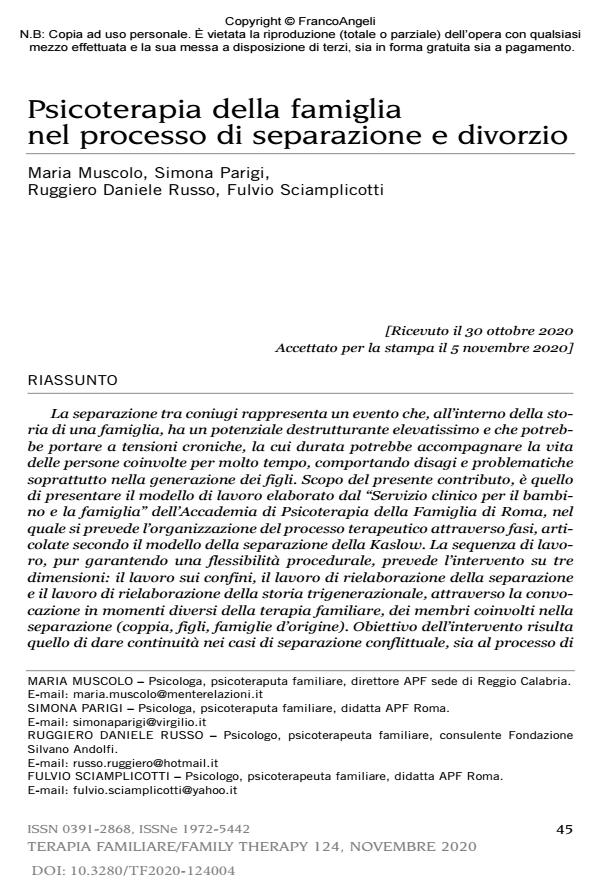Family psychotherapy in the separation and divorce process
Journal title TERAPIA FAMILIARE
Author/s Maria Muscolo, Simona Parigi, Ruggiero Daniele Russo
Publishing Year 2021 Issue 2020/124
Language Italian Pages 31 P. 45-75 File size 152 KB
DOI 10.3280/TF2020-124004
DOI is like a bar code for intellectual property: to have more infomation
click here
Below, you can see the article first page
If you want to buy this article in PDF format, you can do it, following the instructions to buy download credits

FrancoAngeli is member of Publishers International Linking Association, Inc (PILA), a not-for-profit association which run the CrossRef service enabling links to and from online scholarly content.
Separation between a married couple represents an event in a family’s history, potentially leading to rupture thus creating constant tension. This can accompany the people who are undergoing the separation for a long time bringing forth complications and issues especially for children. The goal here is to present the paper elaborated by the Academy of Family Psychotherapy of Rome entitled "Clinical Service for the child and the family". The work demonstrates the organization of a therapeutic process in various articulated phases following Kaslow’s separation model. Even though there is some procedural flexibility, the sequence of the work focuses on three areas: boundaries, re-elaboration of separation and re-elaboration of the history of three generations throughout different moments of family therapy and of the members involved (the couple, children and family of origin). The objective is to give continuity in conflict separation cases focusing on both the development of each individual involved, which risks a halt if ties are broken, and on the family structure as a whole, which faces a rupture in generations. This will allow the children to regain a mother and father which are able to share the parenthood thus liberating the children from conflicts.
Keywords: Separation, children, family psychotherapy, phases of the therapy process
- Fivaz-Depeursinge E., Corboz-Warnery A. (1999). Il triangolo primario: le prime interazioni triadiche tra padre, madre e bambino. Milano: Raffaello Cortina.
- Andolfi M. (1988). La famiglia trigenerazionale. Roma: Bulzoni.
- Andolfi M. (2015). La terapia familiare multigenerazionale: Strumenti e risorse del terapeuta. Milano: Raffaello Cortina.
- Andolfi M. Mascellani A. (2019) Intimità di coppia e trame familiari. Milano: Raffaello Cortina.
- Andolfi M., Falcucci M., Mascellani A., Santona A., Sciamplicotti F. (a cura di) (2006). La terapia di coppia in una prospettiva trigenerazionale. Roma: Accademia di Psicoterapia della Famiglia.
- Andolfi M., D’Elia A. (a cura di) (2007). Le perdite e le risorse della famiglia. Milano: Raffaello Cortina.
- Andolfi M. et al. (2007). Il bambino come risorsa nella terapia familiare. Roma: Accademia di Psicoterapia della Famiglia.
- Arditti J.A., Prouty A.M. (1999). Change and disengagement, and renewal: Relationship dynamics between younh adults and their fathers after divorce. Journal of Marital and Family Therapy, 25: 61-81.
- Bohannan P. (1973). The six stations of divorce. In: Lasswell M.E. (ed.), Marriage and Family. Love, Ill: Scott & C.
- Boszormenyi-Nagi I., Spark G.M. (1973). Invisible Loyalties. London: Harper & Row (trad. it.: Lealtà invisibili. La reciprocità nella terapia familiare intergenerazionale. Roma: Astrolabio, 1988).
- Bowen M. (1979). Dalla famiglia all’individuo. La differenziazione del sé nel sistema familiare. Roma: Astrolabio.
- Cigoli V. (2017). Clinica del divorzio e della famiglia ricostruita. Bologna: Il Mulino.
- Cigoli V., Galimberti C., Mombelli M. (1996). Il legame disperante. Il divorzio come dramma di genitori e figli. Milano: Raffaello Cortina.
- de Bernart R., Francini G., Mazzei D., Pappalardo L. (1999). In: Andolfi M. (a cura di), La crisi della coppia. Una prospettiva sistemico-relazionale. Milano. Raffaello Cortina.
- De Francisci A., Piersanti T. (2015). La famiglia tra vincoli e risorse. Percorsi terapeutici complessi. Milano: FrancoAngeli.
- Emery R.E. (1994). Renegotiating family relationships: Divorce, child custody and mediation. New York: The Guilford Press.
- Emery R.E. (1998). Il divorzio: rinegoziare le relazioni familiari. Milano: FrancoAngeli.
- Emery R.E. (2008). La verità sui figli e il divorzio: Gestire le emozioni per crescere insieme. Milano: FrancoAngeli.
- Fonagy P., Target M. (1997). Attachment and reflective function: Their role in self-organization. Development and Psychopathology, 9: 679-700.
- Kaslow F.W. (1980). Stages of Divorce. A Psychological Perspective, Villanova Law Review, 25, 4: 718.
- Kaslow F.W. (1991). Divorce and Divorce Therapy. In: Gurmand A.S., Kniskern P., Handbook of Family Therapy. New York: Brunner and Mazel.
- Lalli N. (1997). Lo spazio della mente. Saggi di psicosomatica. Napoli: Liguori.
- Lalli N. (1999). Manuale di Psichiatria e Psicoterapia, 2°. Napoli: Liguori.
- Mazzoni S. (1999). Le famiglie separate: problematiche e interventi. Napoli: Liguori.
- Minuchin S. (1974). Famiglia e terapia della famiglia (trad. it.: Roma: Astrolabio, 1978).
- Ponappa S. et al. (2016). Tha family system and depressive symptoms during the college years: triangulation, parental differential treatment, and sibling warmth as predictors. Journal of Marital and Family Therapy, 43(1): 145-158.
- Scabini E. (1995). Psicologia sociale della famiglia. Sviluppo dei legami e trasformazioni sociali. Torino: Bollati Boringhieri.
- Scabini E., Cigoli V. (2000). Il famigliare. Legami, simboli, transizioni. Milano: Raffaello Cortina.
- Scabini E., Cigoli V. (2012). Alla ricerca del famigliare. Il modello relazionale-simbolico. Milano: Raffaello Cortina.
- Stern D.N. (2004). Il momento presente in psicoterapia e nella vita quotidiana (trad. it.: Milano: Raffaello Cortina, 2005).
- Stocker C.M., Youngblade L. (1999). Marital conflict and parental hostility: Links with children’s sibling and peer relationships. Journal of Family Psychology, 13(4): 598-609.
- Whitaker C.A. (1999) Le funzioni del matrimonio. In: Andolfi M. (a cura di), La crisi della coppia. Milano: Raffaello Cortina.
- Putimu stari o 'nda fuimu? Come il dilemma dell'appartenenza interviene nella costruzione del processo terapeutico nel contesto calabrese Simona Parigi, Marika Micalizzi, Maria Muscolo, in TERAPIA FAMILIARE 133/2024 pp.15
DOI: 10.3280/TF2023-133004
Maria Muscolo, Simona Parigi, Ruggiero Daniele Russo, Psicoterapia della famiglia nel processo di separazione e divorzio in "TERAPIA FAMILIARE" 124/2020, pp 45-75, DOI: 10.3280/TF2020-124004